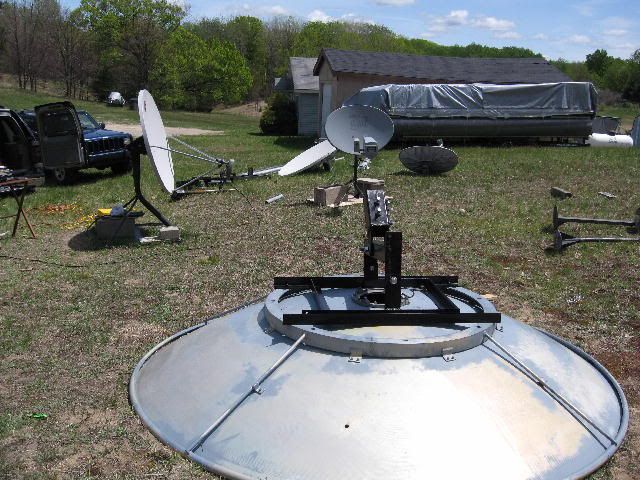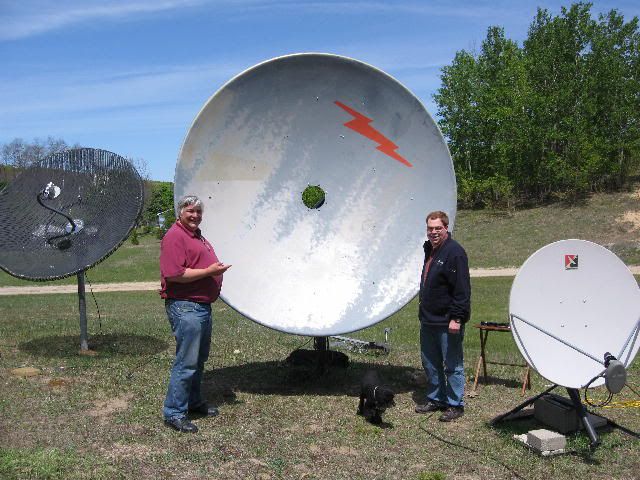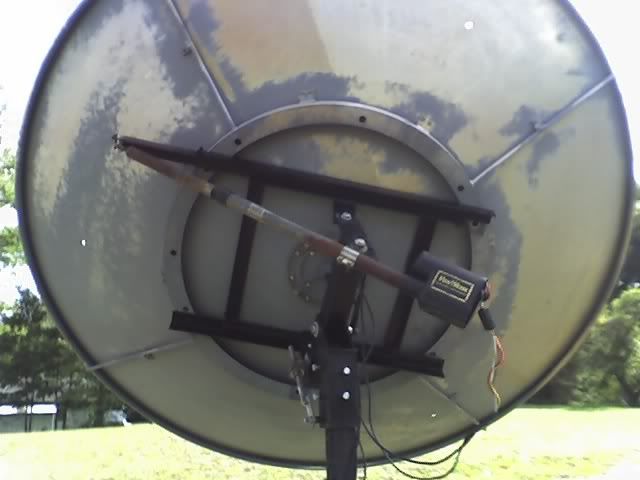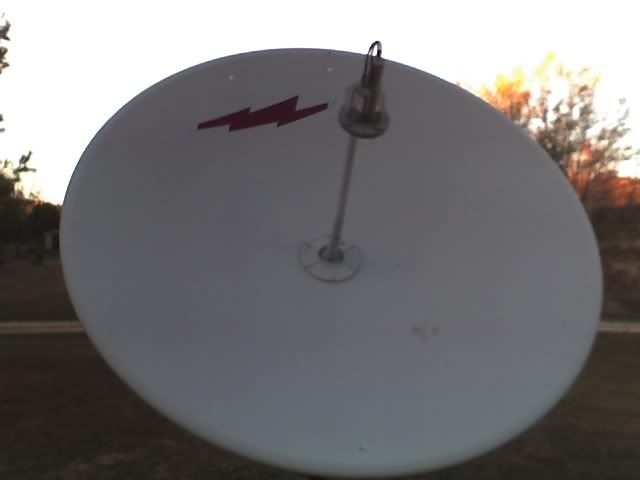Satellite or Microwave?
- Thread starter Apprentice
- Start date
- Latest activity Latest activity:
- Replies 16
- Views 3K
You are using an out of date browser. It may not display this or other websites correctly.
You should upgrade or use an alternative browser.
You should upgrade or use an alternative browser.
- Status
- Please reply by conversation.
Tell us more. Are they in back of a TV or Radio station? An abandoned transmitter site? Home of someone who worked for a communications type company? Radio stations use the "open" style dish for what's called STL (studio transmitter link) in the 900 mhz band (2nd one back in picture) over long distances. In our case around 20 miles.
They are at a railroad yard waiting to be scrapped out. I am not close as they are a ways north of Wichita Kansas. One of the guys here knows I like to play with dishes and saw these. That is why my gut feeling is that the are microwave dishes that were used or radio transmission from tower to tower on he union pacific railroad. Any way all I have seen is the same picture that is here. Told him to just load them up and bring them back to me. If nothing else probably worth some cash for scrap 
best advice right thereTold him to just load them up and bring them back to me.
All microwave.
Agreed!
Back in "the day"....FINCO and Channel Master used to make dish "style" antennas like that, with a UHF rig in front for VERY long distance UHF TV, 70-plus miles. That "open" dish may be able to be modified for that, and I'll bet some distant OTA signals would be available. Only drawback is the same now as then....the bigger the antenna, the heavier the mount (and/or rotor...God forbid) must be!
Back in "the day"....FINCO and Channel Master used to make dish "style" antennas like that, with a UHF rig in front for VERY long distance UHF TV, 70-plus miles. That "open" dish may be able to be modified for that, and I'll bet some distant OTA signals would be available. Only drawback is the same now as then....the bigger the antenna, the heavier the mount (and/or rotor...God forbid) must be!
That is what I think also is they are alum microwave dishes. Well guess we will see what he does. I have no issue with selling them for scrap. they give crap like that away all the time. They don't miss it one bit. could probably be converted? but would be a task I bet.
Look for a brand like "Scala" on the open one before scrapping. Maybe Kathrein (that could be too new of a name, not sure.) Those hold a value to broadcasters, and there are internet broadcaster's classifieds! You'd be surprised how much broadcasters like to save money on equipment. Yes, we're CHEAP.
Usually the "non consumer" type of antennas have a permanent ID plate that weathers pretty well.
Usually the "non consumer" type of antennas have a permanent ID plate that weathers pretty well.
I will have a look 
anything useful I hate to toss but just can not store it all. My wife would kill me.
anything useful I hate to toss but just can not store it all. My wife would kill me.
The giant coax going into the back of the middle dish, and the square mount on the back of it, scream point-to-point microwave.
I see nothing in the pictures to tell the dish size.
And are they one-piece spun aluminum, or segmented?
I'm going to make a WAG (guess) and go with 6 or 8 feet, and one-piece spun aluminum.
Might be wrong, but that's my guess. What do I get if I win?
Regardless if they are 4', 6', or 8', I'd snag as many of the good ones as I could possibly haul!
The are 99% guaranteed to be prime feed, and as long as they're accurate parabolas, should be fine on C-band.
I doubt they are heavy either, once you strip off the front-side feed, and that boxy back-bracket garbage.
One guy might move it, but two should have no problem at all.
Many folks on the forum have converted button-hook dishes to quad-leg.
Follow the Nike mantra, and just DO it ! :up
I see nothing in the pictures to tell the dish size.
And are they one-piece spun aluminum, or segmented?
I'm going to make a WAG (guess) and go with 6 or 8 feet, and one-piece spun aluminum.
Might be wrong, but that's my guess. What do I get if I win?
Regardless if they are 4', 6', or 8', I'd snag as many of the good ones as I could possibly haul!
The are 99% guaranteed to be prime feed, and as long as they're accurate parabolas, should be fine on C-band.
I doubt they are heavy either, once you strip off the front-side feed, and that boxy back-bracket garbage.
One guy might move it, but two should have no problem at all.
Many folks on the forum have converted button-hook dishes to quad-leg.
Follow the Nike mantra, and just DO it ! :up
Apprentice,
You have a valuable find there. The first dish in the center is a 8' Andrew microwave 12ghz judging by the size of the elliptical waveguide stub off the back side. The next dish looks like a 8ft Scala Grid dish guessing that it is in the 900 MHz range, but could be retro fitted with a new driven element for many different services from MHz to 2ghz. Could be sold above scrap value to some broadcaster. The next one looks bent up, scrap it, don't know about the 4th. The dishes to the left stacked against the wall look like they may be off set Ku, the stuff we like to play with. Out of the lot, the 8ft Andrew is the best catch. I was able to rescue one of these from a CATV tower being taken down. I changed out the 12ghz feed with a button hook mount and a C/Ku LNB, mounted it on a polar dish frame. It is the best performing dish in my farm, I'm sure out performing other 8ft dishes out there. It has a solid aluminum with a very accurate surface that works well for both C and Ku.




Microwave yes! convertible to C-band YES, to KU band Maybe
Value ? if commercial customer in Seattle $100 to $300 depending on mount and co-ax / waveguide hookup
Value ? if commercial customer in Seattle $100 to $300 depending on mount and co-ax / waveguide hookup
One other thing of value to consider. . .
That big black cable that goes into the back of the dish.
I forget what the material is called, but it's a corrugated aluminum (?) tube which you can flex (once for installation) without it collapsing.
Obviously, it has a vinyl sheath on the outside, to protect against weather.
Inside, there is a center conductor (maybe a copper wire?) running through the middle.
Between the two, is either an air or gas-filled foam, mostly hollow...
OR, a piece of plastic (maybe teflon?) that is cut in a spiral, to look a lot like spiral pasta.
The way it works, is it holds the center conductor in place, but doesn't soak up any signal; the tube is mostly hollow.
Whether it's then air or gas filled, I don't know. There may be various types.
So, why all the low-loss cabling?
In the old days, the microwave transmitter was a rack full of equipment, and you needed to get all the few milliwatts available, on up to the dish.
Alternately, in radio and TV stations, loss in the cable of 1% of the signal, would create a lot of heating!
Anyway, some advanced Hams, and others may be interested if you have a good length of that low-loss cable.
Even if you don't, the connectors on it may be worth a knight's ransom.
I've been only peripherally associated with such equipment, and that was decades ago.
But, if you've got it, you might find someone who would put it to good use.
That big black cable that goes into the back of the dish.
I forget what the material is called, but it's a corrugated aluminum (?) tube which you can flex (once for installation) without it collapsing.
Obviously, it has a vinyl sheath on the outside, to protect against weather.
Inside, there is a center conductor (maybe a copper wire?) running through the middle.
Between the two, is either an air or gas-filled foam, mostly hollow...
OR, a piece of plastic (maybe teflon?) that is cut in a spiral, to look a lot like spiral pasta.
The way it works, is it holds the center conductor in place, but doesn't soak up any signal; the tube is mostly hollow.
Whether it's then air or gas filled, I don't know. There may be various types.
So, why all the low-loss cabling?
In the old days, the microwave transmitter was a rack full of equipment, and you needed to get all the few milliwatts available, on up to the dish.
Alternately, in radio and TV stations, loss in the cable of 1% of the signal, would create a lot of heating!
Anyway, some advanced Hams, and others may be interested if you have a good length of that low-loss cable.
Even if you don't, the connectors on it may be worth a knight's ransom.
I've been only peripherally associated with such equipment, and that was decades ago.
But, if you've got it, you might find someone who would put it to good use.
wow lots of feed back thanks everyone. I was really unsure if I wanted to even mess with them. I will be working on getting them to a new home 
:upI will be working on getting them to a new home
Heliax (helical coax)Put a lot up on commercial towers BITD. Got a true story about a gas filled one that was "topped off" with the wrong gas.I forget what the material is called, but it's a corrugated aluminum (?) tube which you can flex (once for installation) without it collapsing.
:up Heliax (helical coax)Put a lot up on commercial towers BITD. Got a true story about a gas filled one that was "topped off" with the wrong gas.
- Status
- Please reply by conversation.
Similar threads
- Replies
- 6
- Views
- 268
- Replies
- 8
- Views
- 227


